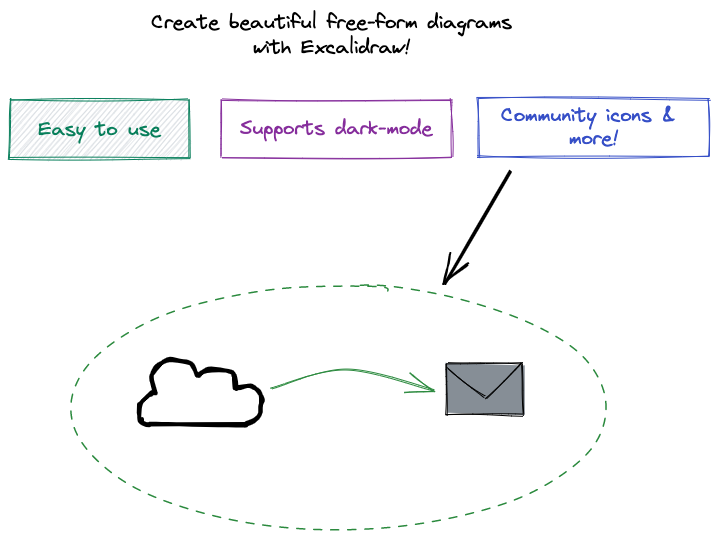Jekyll Theme Primer Spec
Diagrams
Primer Spec offers first-class support for two diagramming tools:
- Excalidraw: Use for free-form whiteboard-style diagrams.
- Mermaid: Use for structured flowcharts and sequence diagrams.
Excalidraw
Excalidraw is my preferred diagramming tool. It’s absurdly easy to create beautiful whiteboard-style diagrams! (It’s also the preferred diagramming tool by engineers at Meta.)
You can visit their website and export the diagram as a PNG or SVG. Alternatively, you can use their official VSCode extension to create diagrams right in VSCode.
When you create a PNG image using Excalidraw, don’t forget to name your file as [your-filename].excalidraw.png. Primer Spec identifies images that are named with .excalidraw, and automatically applies dark-mode styles to them!
As long as you’ve “embedded the scene” into the exported image, your Excalidraw diagrams can be edited any time.
Here’s a demo diagram I created with filename excalidraw-demo.excalidraw.png. Try switching between light and dark-mode to see the image-color change!

Mermaid
Mermaid lets you define diagrams (like flow charts and sequence diagrams) with easy-to-learn Markdown-ish syntax.
This page contains some examples of how you can use Mermaid in your specs!
Usage
Just add mermaid: true to the front-matter of your spec page. For instance:
---
layout: spec
mermaid: true
---
# My Spec
...
Accessibility
Primer Spec allows you to specify titles and descriptions for your diagrams. While they aren’t required, we strongly encourage you to specify them since they are the only way a visually-impaired user can understand the content in the diagram.
Specify them by adding data-title and data-decsription attributes to the diagram. For instance:
```mermaid
graph TD;
A --> B;
```
{: data-title="A simple graph" data-description="A links to B." }
All of the demos on this site have titles and descriptions. We hope you’ll include them in your diagrams too!
Flowcharts
Docs: https://mermaid-js.github.io/mermaid/#/flowchart
Basic example
graph TD;
A-->B;
A-->C;
B-->D;
C-->D;
Show code
```mermaid
graph TD;
A-->B;
A-->C;
B-->D;
C-->D;
```
{:
data-title="Basic example of a flowcchart"
data-description="A links to B and C. B links to D. C links to D."
}
FontAwesome Icons
flowchart TD
B["fa:fa-hand-peace for peace"]
B-->C[fa:fa-ban forbidden]
B-->D(fa:fa-spinner);
B-->E(A fa:fa-camera-retro perhaps?);
Show code
```mermaid
flowchart TD
B["fa:fa-hand-peace for peace"]
B-->C[fa:fa-ban forbidden]
B-->D("fa:fa-spinner ");
B-->E(A fa:fa-camera-retro perhaps?);
```
{:
data-title="Diagram with font-awesome icons"
data-description="B says, 'Peace gesture for peace'. B links to three boxes: C (which says 'forbidden'), D (which has a spinner icon), and E (which says 'a picture perhaps?')."
}
Look for FontAwesome icons on their website: https://fontawesome.com/search?m=free
Subgraphs
flowchart TB
c1-->a2
subgraph one
a1-->a2
end
subgraph two
b1-->b2
end
subgraph three
c1-->c2
end
one --> two
three --> two
two --> c2
Show code
```mermaid
flowchart TB
c1-->a2
subgraph one
a1-->a2
end
subgraph two
b1-->b2
end
subgraph three
c1-->c2
end
one --> two
three --> two
two --> c2
```
{:
data-title="Diagram with subgraphs"
data-description="Three subgraphs, each containing two boxes. Subgraph one has box a1 linked to a2. Subgraph two has box b1 linked to b2. Subgraph 3 has box c1 linked to c2. Subgraph one links to subgraph two. Subgraph three links to subgraph two. Subgraph two links to c2."
}
Sequence Diagrams
Docs: https://mermaid-js.github.io/mermaid/#/sequenceDiagram
A Sequence diagram is an interaction diagram that shows how processes operate with one another and in what order.
sequenceDiagram
participant Adi
participant Barbara
participant C as Chi-Chih
Adi->>C: Hello Chi-Chih, how are you?
loop Healthcheck
C->>C: Fight against hypochondria
end
Note right of C: Rational thoughts <br/>prevail!
C-->>Adi: Great!
C->>Barbara: How about you?
Barbara-->>C: Jolly good!
Show code
```mermaid
sequenceDiagram
participant Adi
participant Barbara
participant C as Chi-Chih
Adi->>C: Hello Chi-Chih, how are you?
loop Healthcheck
C->>C: Fight against hypochondria
end
Note right of C: Rational thoughts <br/>prevail!
C-->>Adi: Great!
C->>Barbara: How about you?
Barbara-->>C: Jolly good!
```
{:
data-title="Example of a sequence diagram"
data-description="Adi says hello to Chi-Chih. Loop Healthcheck shows that Chi-Chih is fighting against hypochondria. Note right of Chi-Chih says Rational thoughts prevail! Chi-Chih says Great! Chi-Chih says How about you? Barbara says Jolly good!"
}
Class diagrams
Docs: https://mermaid-js.github.io/mermaid/#/classDiagram
“In software engineering, a class diagram in the Unified Modeling Language (UML) is a type of static structure diagram that describes the structure of a system by showing the system’s classes, their attributes, operations (or methods), and the relationships among objects.” Wikipedia
classDiagram
Animal <|-- Duck
Animal <|-- Fish
Animal <|-- Zebra
Animal : +int age
Animal : +String gender
Animal: +isMammal()
Animal: +mate()
class Duck{
+String beakColor
+swim()
+quack()
}
class Fish{
-int sizeInFeet
-canEat()
}
class Zebra{
+bool is_wild
+run()
}
Show code
```mermaid
classDiagram
Animal <|-- Duck
Animal <|-- Fish
Animal <|-- Zebra
Animal : +int age
Animal : +String gender
Animal: +isMammal()
Animal: +mate()
class Duck{
+String beakColor
+swim()
+quack()
}
class Fish{
-int sizeInFeet
-canEat()
}
class Zebra{
+bool is_wild
+run()
}
```
{:
data-title="Example of a class diagram"
data-description="Class Animal defines public attributes int age and String gender, and public methods isMammal() and mate(). Classes Duck, Fish and Zebra each inherit from Animal. Class Duck has public attribute String beakColor, and public methods swim() and quack(). Class Fish has private attribute int sizeInFeet, and public method canEat(). Class Zebra has public attribute bool is_wild, and public method run()."
}
State diagrams
Docs: https://mermaid-js.github.io/mermaid/#/stateDiagram
“A state diagram is a type of diagram used in computer science and related fields to describe the behavior of systems. State diagrams require that the system described is composed of a finite number of states; sometimes, this is indeed the case, while at other times this is a reasonable abstraction.” Wikipedia
stateDiagram
[*] --> Still
Still --> [*]
Still --> Moving
Moving --> Still
Moving --> Crash
Crash --> [*]
Show code
```mermaid
stateDiagram
[*] --> Still
Still --> [*]
Still --> Moving
Moving --> Still
Moving --> Crash
Crash --> [*]
```
{:
data-title="Example of a state diagram"
data-description="From start, move to 'Still' state. From 'Still' state, move to either end or to 'Moving' state. From 'Moving' state, either move back to 'Still' state or to 'Crash' state. From 'Crash' state, move to end."
}